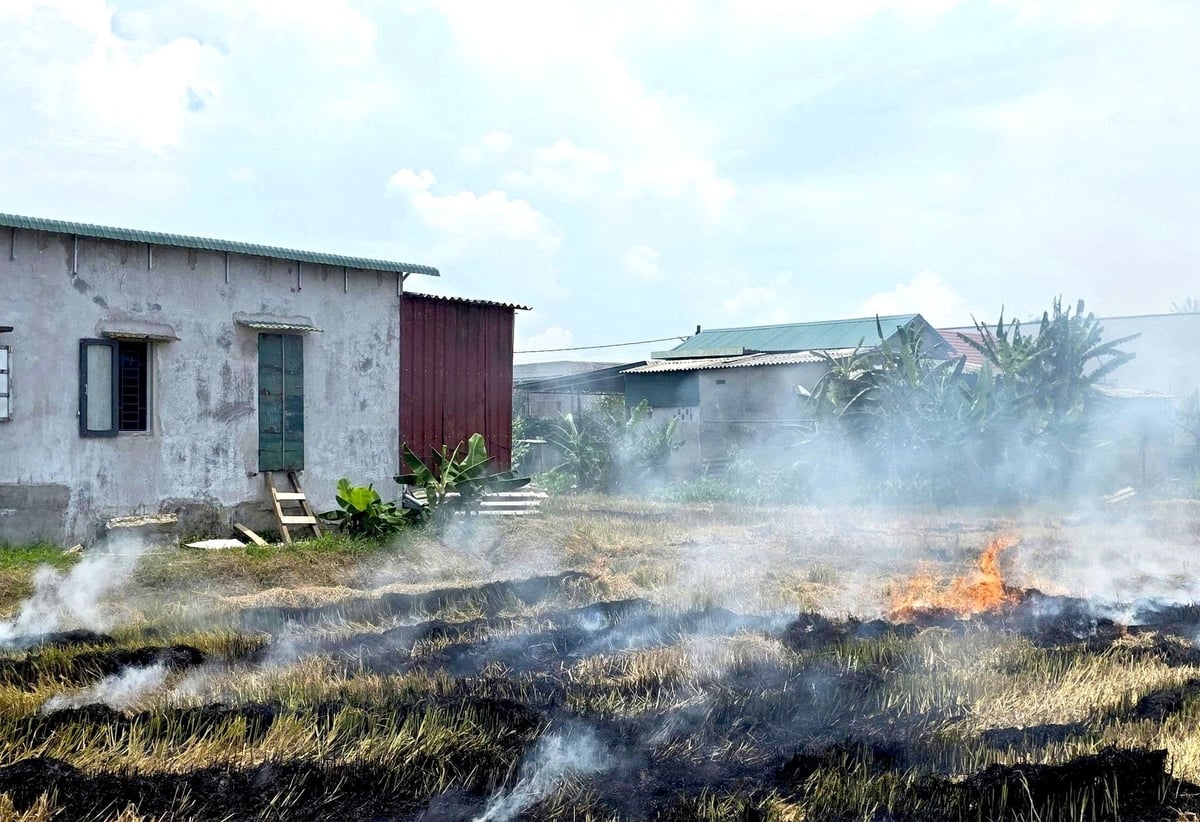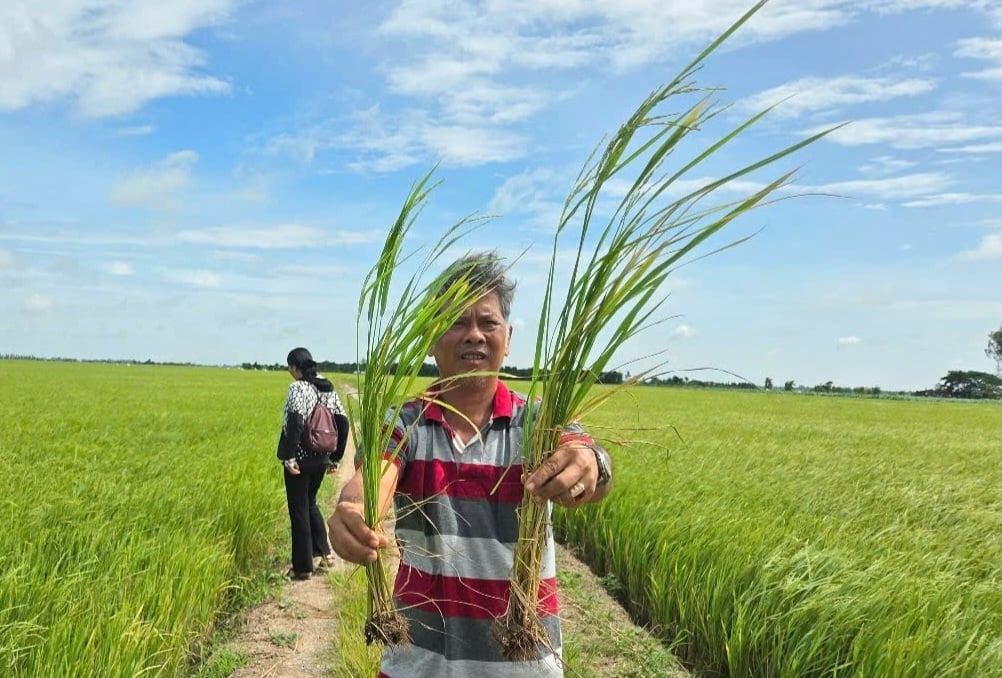October 28, 2025 | 23:52 GMT +7
October 28, 2025 | 23:52 GMT +7
Hotline: 0913.378.918
October 28, 2025 | 23:52 GMT +7
Hotline: 0913.378.918
During harvest season, rice fields across Vietnam face a recurring challenge: rice straw. The most common yet most harmful solution has long been open burning, which produces thick black smoke, pollutes the air, wastes organic resources, and can degrade soil quality.
To tackle this issue, many organizations and businesses have researched and applied technological solutions to turn this agricultural by-product into valuable resources. One example is the ECOMAX (R3) bio-product developed by TMH Environment and Services Co., Ltd. in Hai Phong, which has been widely adopted by local farmers.

Burning rice straw not only causes waste but also harms the environment. Photo: Dinh Muoi.
With this bio-product, farmers no longer need to resort to chemicals or burning. Instead, a consortium of carefully selected beneficial microorganisms is introduced, including cellulose-degrading strains such as Bacillus subtilis, fermenting strains like Saccharomyces cerevisiae, and nitrogen-fixing bacteria such as Azotobacter sp.
Once sprayed or spread across fields where rice straw remains after harvest, and provided there is sufficient moisture, billions of these microorganisms immediately begin their work. Acting like tireless “workers,” they accelerate the breakdown of the rigid structure of rice stalks and leaves. Within 5–7 days, the straw starts to soften, and after about two weeks, it is almost completely decomposed, turning into a fertile, nutrient-rich organic humus.
Beyond decomposing straw, this process also brings several added benefits: it destroys weed seeds and wild rice, interrupts the cycle of plant-borne pathogens hidden in crop residues, and improves soil health. Above all, the greatest value of this technology lies in the direct economic gains it offers to farmers, helping them save on chemical inputs while cultivating healthier, more sustainable fields.
According to Ms. Nguyen Thi Minh, Director of TMH Company, converting rice straw into on-site fertilizer allows farmers to reduce the use of chemical fertilizers by 25–30% for the following crop. In the context of soaring fertilizer prices, this represents a highly meaningful saving.
She cited practical examples from the Mekong Delta: in the past, farmers typically applied about 120 kilograms of fertilizer per cong of land (1,000 m²). Now, many households only need 60–70 kilograms while their rice plants still grow vigorously and remain healthy.

Farmers compare rice plants in fields treated with the bio-product (right) and those grown under conventional methods. Photo: Dinh Muoi.
Properly managing and decomposing rice straw brings multiple layers of benefits for both farming efficiency and environmental sustainability. One of the most important outcomes is the elimination of so-called “organic toxicity,” a major factor behind yellowing leaves and root suffocation in young rice plants. When straw is broken down with the help of beneficial microorganisms, the soil structure improves significantly, it becomes looser, more aerated, and enriched with a diverse community of helpful microbes. This healthy soil environment allows rice roots to grow deeper and stronger, improves nutrient uptake, and enhances the crop’s natural resistance to pests and diseases. As a direct result, farmers are able to cut back considerably on their use of pesticides and other plant protection chemicals.
The environmental gains are even more far-reaching. By eliminating the traditional practice of burning rice straw, air quality improves and harmful greenhouse gas emissions such as methane (CH₄) and carbon dioxide (CO₂) are reduced. Instead of being lost, the valuable carbon stored in straw is returned to the soil, sustainably enhancing fertility and moving agriculture toward a circular, low-emission model.
According to Ms. Nguyen Thi Minh, the ECOMAX bio-product has now been applied in many provinces and cities. Beyond Hai Phong, it has been actively adopted in major rice-growing areas, particularly in the Mekong Delta. The greatest challenge at present, she noted, lies in changing long-standing farming practices and mindsets on a wide scale. Achieving this requires coordinated efforts from businesses, scientists, and government authorities.
“We are actively working with cooperatives and local administrations to organize demonstration models, provide technical training, and develop supportive policies so that the product can be more easily accessible to farmers,” Ms. Minh shared.
“Applying microbial technology to treat rice straw is not only a solution to environmental challenges but also an important step toward smart and sustainable agriculture. With the right application, science and technology can transform what seems like agricultural waste into a valuable resource - helping farmers cut costs, increase profits, and practice farming in a safer and more sustainable way,” Ms. Minh affirmed.
Translated by Phuong Linh

(VAN) The Integrated Plant Health Management (IPHM) helps farmers in Quang Ngai increase rice production efficiently and sustainably.

(VAN) Developing low-emission cultivation technology packages, MRV system, strengthening multi-stakeholder cooperation are to realize the goal of low-emission crop production.
/2025/10/23/5928-2-194850_964.jpg)
(VAN) The 'Regenerative cocoa production to support livelihood development in Vietnam' (ReCoPro) project marks an important step toward sustainable cocoa production.

(VAN) Reducing antibiotic dependence in livestock production helps protect public health, enhance food safety, and promote sustainable agricultural development.

(VAN) Experts describe Viet Nam as a 'policy laboratory' within ASEAN, where new agroecological, green finance, and risk-management initiatives are being piloted before wider regional adoption.

(VAN) Limiting rice straw burning and reusing agricultural by-products as materials or fertilizers not only improves soil health but also helps clean the air.

(VAN) ASSET delivers long-term vision and strategy, innovative models, learning networks, policy impact, and measurable environmental benefits.